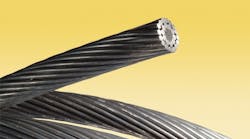An 11-year field test of 3M Aluminum Conductor Composite Reinforced (“ACCR”), in cooperation with Hawaii Electric Company, on a 46-kV distribution line on the island of Oahu has confirmed the salt spray corrosion resistance of the high-capacity, low-sag, lightweight overhead conductor.
Because transmission conductors are expected to operate for decades in a variety of harsh environments, validating the corrosion performance of ACCR in a long-term field test can help utilities be confident when using the conductor. Oahu is an ideal location for corrosion field testing because the sea spray laden trade winds produce a highly corrosive environment. In fact, standard steel core and aluminum conductors typically do not last more than about three years in this environment. 3M ACCR was installed for 11 years.
Corrosion can affect the weight and strength of conductor materials. Tests performed recently on samples of ACCR conductor strung in late 2002 showed no appreciable loss of either tensile strength or weight. Tensile strength remained between 105 and 107 percent of rated breaking strength. Examination of core wires with both optical and scanning electron microscopes showed no indications of corrosion or pitting.
3M ACCR was introduced commercially in 2004 and is now installed on five continents. Because its light weight and low sag properties often enable line upgrades without the need to construct larger towers or expand rights of way, the conductor has found widespread use in crowded urban settings and environmentally sensitive locations, such as river crossings and estuaries.
“The field test in Hawaii was designed to measure 3M ACCR’s dependability in highly corrosive salt spray environments ,” says Dr. Herve Deve, technical manager for the 3M High-Capacity Conductor Program. “The results of the tests are consistent with 3M ACCR’s high level of performance in extreme conditions.”
Fred Schiller, business director for the ACCR program, notes that 3M ACCR also is performing to expectations in other punishing climates. “From Siberia to equatorial Africa, the conductor has proven its reliability and cost effectiveness in a variety of applications in places where line upgrades are difficult,” he says. “It can double ampacity with less weight and sag, reducing the need to build larger towers or acquire wider rights of way, simplifying logistics and minimizing environmental and community issues.”
3M ACCR was developed with the support of the U.S. Department of Energy, which tested the conductor at its Oak Ridge National Laboratory (ORNL) in Tennessee, and with early contributions by the Defense Advanced Research Projects Agency. The ORNL tests demonstrated that the conductor retains its integrity after exposure to temperatures even higher than the rated continuous operating temperature of 210 degrees Celsius and the emergency operating temperature of 240 degrees Celsius. It has the durability and longevity of traditional steel core conductors, even when operated continuously at high temperatures.
The conductor’s strength and durability result from its core, composed of aluminum oxide (alumina) fibers embedded in high-purity aluminum, utilizing a highly specialized and proprietary process. The constituent materials can withstand high temperatures without appreciable loss in strength.
Also, since 3M's ACCR is based on aluminum, it has the corrosion resistance typically
associated with all-aluminum conductors.
More information about the 3M high capacity conductor is available at www.3M.com/accr.

Voice your opinion!
Voice your opinion!
To join the conversation, and become an exclusive member of T&D World, create an account today!
Latest from Overhead Transmission
Latest from Overhead Transmission

